Wessex Archaeology record of over 1,000 years of uninterrupted settlement has been discovered in a huge archaeological excavation across six square kilometres (almost two and a half square miles) near Cambridge.
Up to 35 archaeologists have worked on and off for seven years at the site at Cambourne, nine miles west of the city, in advance of the construction of a new settlement with 3,300 homes.
Cambourne has given Wessex Archaeology, which carried out the work, an insight into the way the land was used in the Iron Age, during the Roman occupation and through to Saxon times to grow crops and keep animals, and how the Celts lived both before and after the Roman invasion.
The objects found at Cambourne include a collection of Roman domestic items, dating mainly to the 4th century and including cutlery, keys, tweezers, brooches and pins.
Cambourne is remarkable for the fact that we have evidence of settlement in the same place from about 800BC to 800AD. Archaeologists rarely get such an extended picture of the use of the landscape.
This is made even more remarkable for the fact that no one expected anything to be found at Cambourne – archaeologists had first thought that no settlement existed on the thick clay soils until Medieval times.
This project site gives more details of work on what is one of the largest sites ever excavated in Britain.
Archive
The archive for this project has now been deposited with Cambridgeshire County Council Heritage Services.
Publication
This Volume is out of print. Read the full report below or download a FREE pdf.
Specialist Appendices to accompany the book
To read these reports online follow this link.
to download these reports is PDF documents click on the links below.
- Appendix 1: Contents and Concordance of site and details of archive (696KB)
- Appendix 2: Pottery (1.9MB)
- Appendix 3: Glass (355KB)
- Appendix 4: Metalwork (1.2MB)
- Appendix 5: Coins (317KB)
- Appendix 6: Flint, Stone and Shale (822KB)
- Appendix 7: Worked Bone (285KB)
- Appendix 8: Ceramic Building Materials (CBM) and Fired Clay (286KB)
- Appendix 9: Slag (150KB)
- Appendix 10: Human Bone (360KB)
- Appendix 11: Animal Bone and Marine Shell (2.3MB)
- Appendix 12: Charcoal (637KB)
- Appendix 13: Charred Plant Remains (2.5MB)
- Appendix 14: Waterlogged Plant Remains (412KB)
- Appendix 15: Molluscs (508KB)
- Appendix 16: Pollen Sediments (472KB)
The Background
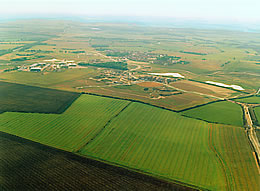
The expansion of high-tech industries in Cambridge (known informally as “Silicon Valley”) has brought a demand for more housing in the county. Developers have considered options for building since the 1980s.
In 1998 work began on constructing 3,300 homes by a developers’ consortium, now comprising Bovis Homes, Bryant Homes and George Wimpey. This will continue until about 2009.
Under planning procedures, developers must ensure before work begins that no archaeological remains will be destroyed by construction. So in 1989, years before the builders began putting up the first homes, Wessex’s staff started their work.
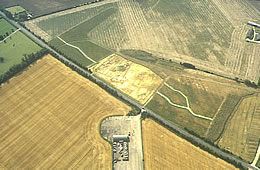
The initial phase was to produce what archaeologists call a desk-top assessment. This is an investigation of records of all the archaeological finds and important sites near the area where the houses are to be put up.
This assessment found that nothing of any great interest had been found at or near to the Cambourne site, and predicted there was little chance of anything being found under the ground. However, because the site was so large the county council recommended further investigation.
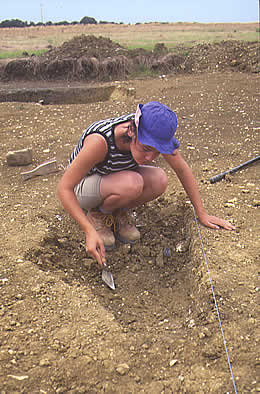
Wessex Archaeology then carried out what archaeologists call an evaluation, in which a mechanical excavator was used to dig a series of trial trenches 50 metres long and two metres wide across parts of the site to see if anything lay below that would warrant a full excavation.
Three years of work and two hundred trenches revealed nothing, until one day in November 1999 when Vaughan Birbeck, a senior project officer, came across evidence of ditches dug during the Iron Age and Roman periods. These quite clearly showed that there had been a substantial settlement nearby. Other trenches he dug later showed more evidence of ditches and enclosures.
Cambourne was clearly not the archaeological desert people had assumed, and it was time to look closer at the site.
Now a total of 724 trenches have been dug, and 20 hectares (50 acres) of land excavated within an area of 600 hectares. The results of this huge investigation have intrigued archaeologists since.
Bronze Age (c800BC)
The beginning of human activity at Cambourne can be dated approximately to the Late Bronze Age (c800BC). We found some pieces of pottery and charred grain, chaff and hazelnut fragments, indicating that crops were grown and used here. The evidence suggests that the area was forested and that people had cut clearings and built farmsteads from around 800BC.
Iron Age (700BC-AD43)
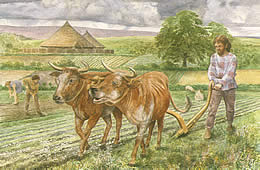
But it was from 700BC onwards, during the Iron Age, that intensive farming at the site developed. The Celts who lived in the area farmed fields of wheat, grew peas and beans, ate hazelnuts and fruit, and erected enclosures for settlements and droveways for their animals. We found the bones of sheep, cows and goats, and a few of pigs,horses and dogs.
The enclosures were areas of land enclosed by ditches; from the shells of snails we found in them, we know these ditches were frequently filled with water, telling us something about the climate at the time.
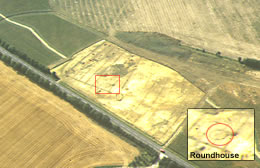
Inside the enclosures were one or two round-houses about 15 metres (50 feet) across. These were made from wattle and daub (wooden stakes interwoven with twigs and smeared with mud to form a solid surface), and with a thatched roof. Inside would live a family and some of their animals, sometimes together in one large room, sometimes with the animals in a separate area. Some of the round-houses had hearths where fires were burnt. In all, 24 round-houses from this time were found at Cambourne in six small dispersed farmsteads. It is possible that a Celtic chieftain owned the land as part of a large estate and organised the landscape.
The evidence of the daily life of these Celtic farmers turned up as Wessex Archaeology staff dug the trenches. Pottery typical of this period was found, as were a bone needle, two ceramic loom weights for weaving cloth, and pieces of broken querns (a stone used to grind cereals by hand).
Roman period (AD43-410)
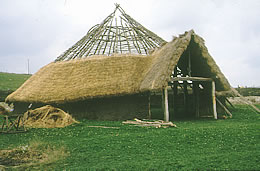
What makes Cambourne interesting for archaeologists is the evidence for both continuity and change in the landscape. Although archaeological evidence is sparse for the first century of Roman occupation (which began in AD43), we know that by AD150 people were farming, often using the same settlements as before, though their enclosures were now more regular in shape and the field boundaries were altered.
As well as using the same farms, the Britons under Roman rule continued to farm in the same way, growing crops and keeping animals, mainly sheep, goats and pigs. We know something about the way they farmed from finding a ploughshare and a sickle. We found evidence of the droveways that they used to move their animals from paddocks into the fields and back.
In what is an unusual development, the local people adopted some aspects of Roman culture but decided they would stay true to their own traditions in other areas.
They were happy to use Roman pottery and glassware and to begin to eat off flat dishes, to use olive oil from Spain and to cook stews in pots. However, unlike most Britons in Roman Britain, they continued to live in round-houses built in the same way as they did before the Romans came. Though they would have seen the usual Roman style of housing for peasants – square buildings with mortar or earthen floors and wooden walls – they kept to the old ways. It is not the case that the Britons living here knew little of the Roman culture for the site was a few miles from the Roman road, Ermine Street, which ran from London to York. The people living here would have seen the fruits of trade from across the Roman Empire and beyond, but deliberately chose not to adopt the Roman style of housing.
The Roman pottery found at the site included Samian cups and bowls from central Gaul and Spanish amphorae (large two-handled jar used to hold wine or oil). Also found on the site were everyday items like nails and hobnails, keys, brooches, a finger ring, a hairpin, spoons and knives. Three impressive pewter plates were the most expensive objects found. However, for a settlement this size, the number of finds is relatively few and tells us that the general rise in prosperity in rural Britain in the later Roman period didn’t reach the people living at Cambourne.
As time passed the use of the landscape changed – we know this from our discovery of about a dozen skeletons from the later Roman period. One was of a man whose head had been removed from his body after death, a common burial practice in Roman times whose meaning is obscure. Often the head is placed with the body but in this case it was never found. In another part of the site, several skeletons were found in a ditch, and elsewhere some skeletons were found which had been placed in coffins which have since rotted away – this tells us that disused parts of the farms were being used as cemeteries in the 3rd and 4th centuries.
Saxon and Medieval (AD410-15th century)
The farmsteads that had been occupied for more than a millennium were still used after the Romans withdrew from Britain in the early 5th century. By the ninth century, however, the landscape was changing and people across Britain were beginning to move from isolated settlements into villages, to places like Caxton in the case of people living on the Cambourne site.
Medieval ploughs destroyed almost all the archaeological evidence in the area, so our knowledge of this period is patchy, but we believe the land had been turned into regular strip fields where villagers grew their crops until the land was enclosed and farmed privately in the first half of the 19th century and farmhouses were built.
The Finds
The objects found at Cambourne will be given to a local museum or library for display so that everyone can see them. Wessex Archaeology’s work at the site is coming to an end and its final detailed report on its findings will be written and a copy given to the local council to put in its Sites and Monuments record (SMR). View more finds on our Cambourne gallery on Flickr.
 |
|
 |
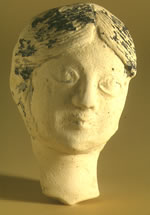 |
 |
|
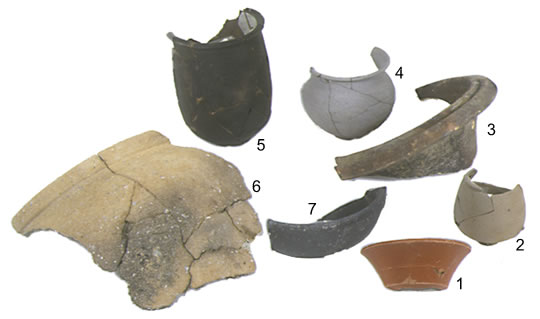
1-2 Small drinking vessels (cups)
The grey one (2) was probably made locally to the north of Peterborough while the red "samian" cup was imported from Gaul (France).
3-7 Kitchen vessels
5&6 were probably storage vessels for dry goods such as flour or pulses although 5 may also have been used over a fire as a saucepan. 3&7 were also cooking vessels. Vessels of this type may have been used together, the shallow dish (7) being inverted and used as a lid over the deeper bowl (3) as a casserole. (4) is of slightly higher quality and represents a medium-quality vessel between the range of coarse cooking/storage pots and the fine table-wares such as (1).
Metalwork
A small selection of finds are displayed above. Click the images to see a larger photograph and a detailed description.
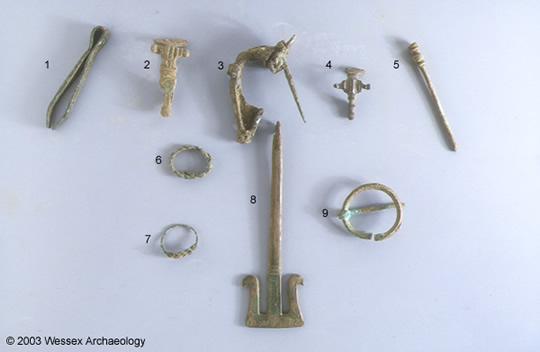
Items of personal jewelery and personal adornment
All are made of copper alloy. The brooches (2, 3, 4 & 9) are all of 1st century AD date while items such as the tweezers (1), hair pins (5) and finger rings (6 & 7) were used throughout the Roman period.
The girdle hanger (8) was a symbol of the status of a Saxon lady. It would have hung from her belt, a symbol of her position as a wife and mistress of a household.
Roman pewter
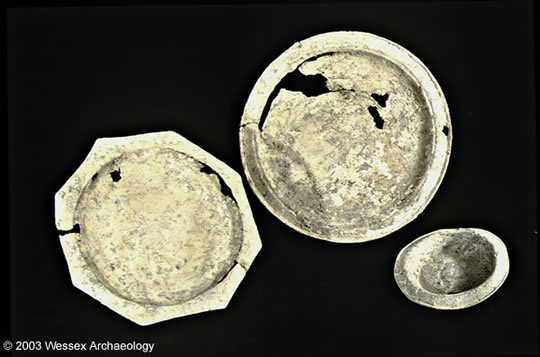
These two pewter plates and the smaller, deeper dish are likely to have been deliberately buried as a "hoard", for safety and later retrieval.
They date to the later 3rd or more probably 4th century AD and are relatively rare and unusual finds because pewter (and other metal) vessels would generally be melted down and the metal reused when they became damaged or their owners did not want them any more.
Roman glass
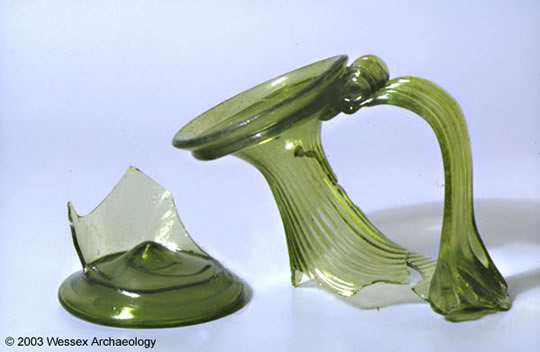
Pieces from one of five complete glass vessels (this jug, 3 cylindrical bottles and 1 hexagonal bottle) found inside a very large pottery jar at Lower Cambourne Green. The glass and pottery are all of a very late 3rd or 4th century date.
Although found in pieces, the glass vessels were probably complete when buried, presumably for safe-keeping but never collected, although it is possible that they were offered to the gods.
See the display material created for this site below.


